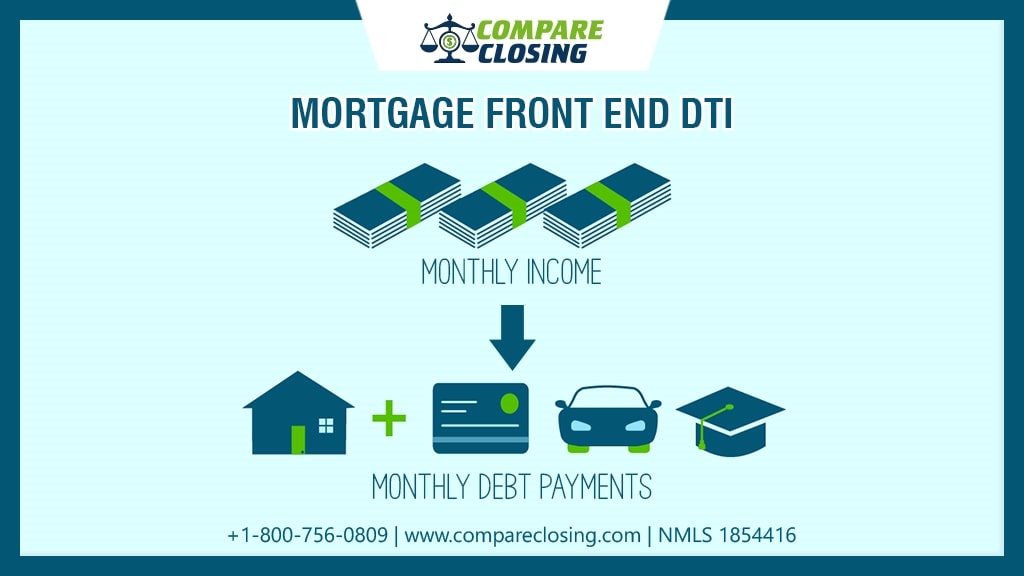Table of Contents
- What Are Netting Escrows & How Does It Work?: The Best Guide - January 2, 2024
- The Secret About Prescriptive Easement: Top Guide 1 Must Know - December 4, 2023
- About Home Equity Loans In Texas And How Can One Obtain It - November 27, 2023
About Mortgage Front End DTI
When you are planning to buy a new property with a mortgage, your lender will qualify you based on a few parameters.
One of the most important parameters that your lender would qualify is called debt to income ratio (DTI).
Usually, your DTI is divided into two parts, front-end, and back-end. In this post, we will understand what is front end debt-to-income ratio and how is it calculated.
What Is Front End DTI?
The front-end DTI ratio, also known as the housing ratio is the maximum acceptable percentage of your monthly gross income that can be spent on total housing costs every month.
These housing costs consist of mortgage loan repayments (principal and interest), homeowner’s insurance, and property taxes.
These costs may also include possible housing-related expenses such as homeowner association (HOA) fees, flood insurance, and private mortgage insurance.
Even if you pay some of these expenses every year or every six months, the lender will calculate their monthly cost and include them in the debt portion of your debt-to-income ratio.
How Is Front End DTI Calculated?
It is very simple to calculate the mortgage front-end ratio by yourself. You need to add all your potential housing expenses like your mortgage payments including principal and interest, home owner’s insurance, property taxes, HOA fees (if applicable), mortgage insurance (if the down payment is less than 20%), and flood insurance (if required).
Then you need to divide this expense with your monthly gross income and multiply by 100 to convert it into a percentage. Below mentioned is the formula to calculate the front-end DTI.
Front End Debt To Income = (Total Housing Expense ÷ Monthly Gross Income) x 100.
Let’s take an example:
Mortgage Payments (P+I): $1,500
HOI: $500
MI: $200
HOA: $150
Total Housing Expense = $2,350
Monthly Gross Income: $6,500
Front End DTI = (2350÷6500) x 100
= 0.3615 x 100
= 36.15%
In the above example, your mortgage front-end debt to income ratio is 36.15%
What Is The Standard Front End DTI Required?
To acquire a mortgage loan, an individual must usually have a debt-to-income ratio that is below a specific level.
Even if you pay your bills on time, having a stable income and a good credit score does not necessarily mean that you can qualify for a mortgage loan.
In the mortgage world, whether you can afford a mortgage along with your housing expense is determined by your DTI.
Generally, it’s a comparison of your household expenses and your monthly debt obligations against your income.
Higher ratios tend to increase the probability of defaulting on the mortgage. This is what happened in 2009.
Many borrowers had mortgage front-end debt to income that was higher than average, and as a result, mortgage delinquencies began to mount.
In 2009, the government introduced loan modification programs to bring this DTI below thirty-one percent.
Lenders typically want this DTI of no more than 28%. Depending on your credit score, savings, and down payment, lenders may accept higher ratios, although it is based on the type of mortgage loan you are trying to acquire.
However, the back-end of DTI is considered by many financial experts to be more important for mortgage loan applications compared to front-end debt to income.
What Is The Difference Between Frond End And Back End DTI?
The main difference between the front-end debt-to-income ratio and the back-end debt-to-income ratio is how the two are being calculated.
With front-end debt to income, calculations are based only on your household expenses. However, the back-end DTI considers other financial obligations, including:
- Monthly rent.
- Monthly repayment of loans in installments such as car loans or personal loans.
- Monthly alimony and child support.
- Monthly student loan payments.
- Monthly payments on revolving debt, such as lines of credit or credit cards.
- Monthly payments for investment properties owned.
The back-end debt-to-income ratio is more significant because it takes into account all of your debt payments outside of the housing expense.
A back-end debt to income ratio is usually considered to be good if it is between 33% to 36%.
Conclusion
The lenders need to see the DTI understand the borrower’s financial strength. If there is enough income generated by the borrower compared to the debts, it shows that the borrower is great at managing his or her finances and is less likely to default.
If you are looking to buy a home using a mortgage, make sure you calculate your front-end debt-to-income ratio to anticipate your housing affordability.
Amanda Byford
Amanda Byford has bought and sold many houses in the past fifteen years and is actively managing an income property portfolio consisting of multi-family properties. During the buying and selling of these properties, she has gone through several different mortgage loan transactions. This experience and knowledge have helped her develop an avenue to guide consumers to their best available option by comparing lenders through the Compare Closing business.





